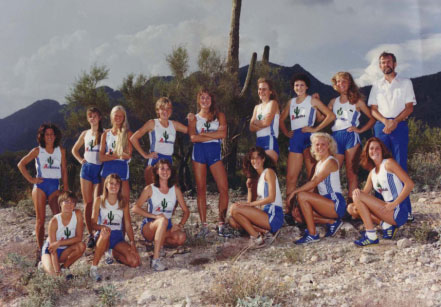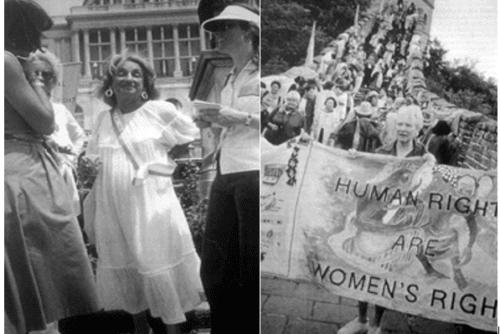The pervasive public rhetoric that devalues women’s sports achievements at the same time it holds up female athletes as superwomen who are different from most women informed a large part of my ambivalence toward the sporting empirical that Stimpson referenced in her quote from my life story. This ambivalence is something I have written about repeatedly for the last ten years, as it is an ambivalence particularly reflective of larger cultural issues and trends. It arises in response to contextual factors such as the institutional structures that govern sport, the larger economic factors associated with these, and the way both impact, and are impacted by, dominant cultural ideologies of gender undergoing significant negotiation. 1 I am assuming, according to the precepts of a contextual cultural studies model, that personal narratives “don’t claim to show a real, valid culture underneath the official version waiting to be revealed,” but rather serve, when analyzed contextually, to “expose dominant configurations of power . . . by tracing the articulation of economic, political, and social forces in the cultural field” (King, 31, 33). 2 Some of those factors include the fact that my high school and college running career took place in the early 1980s post Title IX and therefore at a time when I had athletic opportunities an earlier generation did not have.
But I was also beginning college at the same time as the regulatory structures shaping intercollegiate sport were undergoing significant change, as the male-dominated NCAA took over the female-operated Association for Intercollegiate Athletics for Women (AIAW), which had been the controlling body for women’s athletics at the collegiate level during the 1970s. I can remember my college coach reassuring all the scholarship athletes on the women’s cross country team that this shift to the NCAA (which had only happened months before I began college) was good for us in that we would get more stable funding throughout our college careers, as well as better access to media coverage and to a more highly developed network of competitive events. Trained as we were in the precepts of individual achievement and opportunity divorced from any larger factors, I remember us all agreeing that the switch to the NCAA (women don’t know how to run large public institutions anyway, right?) gave us much better opportunities than those we would have been afforded under the marginalized AIAW. Given that our ideological training in the early 1980s, the Reagan/Thatcher years, took place in the larger context of a neoliberal agenda that promoted globalization through the deregulation of trade barriers and emphasized economic growth as the way to end all social problems, it is not surprising that we internalized this kind of thinking. Nor is it surprising that our allegiances reflected a movement away from the more socially progressive, community oriented ideologies of the 1960s and 1970s put forward by female athletic educators and toward the fiercely competitive individualism of the 1980s and beyond.
I. Immanence, Transcendence, and Neoliberalism
Of course, this distinction was not something I was aware of then. In order to make sense of the emergent discourse of neoliberalism – defined as “the Washington consensus of deregulation, privatization, structural adjustment programs, and limited government” 3 – as the backdrop for my competitive athletic career in the Reagan 1980s, as well as to make sense of the contradictory positionalities of women in sports more generally, I have found a theoretical model borrowed from ecofeminism most informative. In Mary Mellor’s 2000 essay, “Ecofeminism and Environmental Ethics: A Materialist Perspective,” she argues that in Western philosophical traditions that inform gender relations, as well as relations of race, class, and sexuality, “women are materially placed between ‘Man’ and ‘Nature.’ In a very real sense, gender mediates human-nature relations.” This is so, Mellor argues, because “women embody nature both materially and symbolically. Unlike dominant men who are represented historically as in culture and above nature (transcendent), women are represented as steeped in the natural world of the body (immanent)” (212). 4 Of course, some men (wealthy, white) are more fully associated with culture and transcendence than others, and some women (poor, non-white) are more associated with nature and immanence than others, for these designations are raced and classed as well as gendered. As might be read in the picture below, the primarily white women, and very skinny white women at that (the thin body is coded as transcendent, the ample body as immanent), of my intercollegiate cross country team perhaps came as close to transcendence as women are ever allowed to come. Indeed, I would argue that a large part of our fierce dedication to our sport was this quest to ascend to the space of power occupied by white men with money. For at the time, the precepts of liberal feminism promised us equal opportunity and access to this space, with sport constructed as a training ground for the skills we would need to compete there. That we were attending the university on scholarships was dependent upon these liberal premises, which had informed the passage of Title IX and given us unprecedented opportunities. 5

Mellor’s argument does not just rest on identifying the binaristic division between transcendence and immanence that informs gender, however. Very important for my discussion of women in sport, she also shows how
the association of women with nature represents hu(man)ity’s need to confront its own materiality – that is, humanity’s existence in ecological and biological time . . . Hu(man)ity as a natural species is embodied in its physical being and embedded in its natural context. Ecological time is the time it takes for organisms, individuals, populations, and communities to undergo repair, renewal, change, and evolution . . . biological time reflects the time-scale of the human life cycle and its need for rest, repair, and renewal. Women’s socioeconomic position can therefore be seen as representing the way in which male dominated society makes women responsible for the needs of humanity in relation to ecological, and particularly, biological time. This is because women’s work largely concerns the needs of bodily life . . . The historical identification of women with the natural is not evidence of some timeless, transcendental, unchanging, abstract essence, but of the material exploitation of women’s work . . . Someone has got to live in biological time, to be available for crises, the unexpected as well as the routine. 6
Within the structure of globalization and its emphasis on dematerialization and the currency of information (“the information economy”), what is forgotten is the way humans as a species are “embodied in physical being and embedded in natural context.” Mellor’s emphasis on two different modalities of time is crucial here. Ecological time, the time of evolution and ecological process, is the longest time scale. Biological time, which mirrors the human life scale, extends itself over an individual’s lifespan. Both of these kinds of time, Mellor argues, are what contemporary economic practices have struggled to forget, displace, and transcend:
Western society has been created above and against nature, using the sex/gender division of labor as (one) of its vehicles to sustain itself and promote economic wealth . . . [W]omen’s underpaid and unpaid work fuels profitability by being used to bridge the gap between the pace of ecological and biological time (the needs of the body and the natural world) and the unsustainable pace of commodified society. In Western societies, power has been defined and “realized” by the ability of certain privileged individuals and groups to (temporarily) free themselves from embodiedness and embeddedness, from ecological time and biological time. They do so by ignoring or running roughshod over both ecological time, which represents the pace of ecological sustainability for nonhuman nature, and biological time, which represents the life cycle and pace of bodily replenishment for human beings. 7
A hallmark of the contemporary social order based on globalization, then, is the way it “runs roughshod” over ecological and biological time, ignoring or forgetting their existence, with privileged individuals “freeing themselves from embodiedness and embeddedness” as, precisely, an exercise of power. Such “freedom” involves subscription to a different, faster modality of time. Much of the literature emphasizes that within globalization, time is characterized by “time-space compression . . . the way in which instantaneous electronic communication erodes the constraints of distance and time on social organization” – a speeding up that facilitates the (temporary) transcendence of biological and ecological time. 8 I will designate this modality of time-space compression as “tech time.” Tech time – which maintains a focus only on the global economic and media structures to the exclusion of the biological and ecological worlds that sustain them – is related to the bottom-line focus of the neoliberal agenda, which says not only that the free market and its “progressive” technologies are the best possible system, but that “this is the way things will always be and the way they were always meant to be.” 9 Within this way of being, economic growth and the accumulation of wealth are the only things of importance, and are marked by the “increasing concentration of value, and value-making, in the financial sphere”. 10 The dominance of this view is sustained by, in the words of media scholar Robert McChesney, “the global media system, [which is] better understood as one that advances corporate and commercial interests and values and denigrates or ignores that which cannot be incorporated into its mission . . . [W]ith hypercommercialization and growing corporate control comes an implicit bias in media content. Consumerism, class inequality, and individualism tend to be taken as natural and even benevolent, whereas political activity, civic values, and anti-market activities are marginalized.” 11 Since, as scholars have established throughout the last twenty years, competitive sport tends to be linked to individualism, hypercommercialization, and corporate sponsorship, it is this version of sport that is represented in the media, although it does not encompass the potentiality of sport as a whole. Sport, as an immanent practice that aims for transcendence of the body’s limitations, marks a liminal space between biological time and the kind of time associated with globalization and transcendence, and it can be experienced differently in different contexts. The later part of the paper will take up the different, non-dominant modalities of sport.
- See especially The Proving Grounds (Los Angeles: Red Hen Press, 2005); Pretty Good for a Girl: A Sport Memoir (Minneapolis: University of Minnesota Press, 2000); Bodymakers: A Cultural Anatomy of Women’s Bodybuilding (New Brunswick, NJ: Rutgers University Press, 1998); Built to Win: The Female Athlete as Cultural Icon (Minneapolis: University of Minnesota Press, 2004).[↑]
- Samantha King, “Methodological Contingencies in Sport Studies,” in Qualitative Methods in Sport Studies, ed. David Andrews, Daniel S. Mason, and Michael L. Silk (Oxford: Berg, 2005).[↑]
- Held and McGrew, “The Great Globalization Debate,” 5.[↑]
- Mary Mellor, “Ecofeminism and Environmental Ethics: A Materialist Perspective,” in Environmental Philosophy: From Animal Rights to Radical Ecology, ed. Michael E. Zimmerman, J. Baird Callicot, Karen J. Warren, Irene J. Klaver, and John Clark (Upper Saddle River, New Jersey: Pearson/Prentice Hall, 2005), 208-227. Mellor’s argument is itself reminiscent of Susan Bordo’s discussion, in Unbearable Weight: Feminism, Western Culture, and the Body (Berkeley: University of California Press, 1993), of the liberal and radical feminisms of the 1970s and 1980s, which tended to be characterized by what Bordo terms the “Transcenders” and the “Red Bloomers”: “On the one side are the “Transcenders – for whom the female body, undetermined by nature or history, can be recreated anew by feminism. On the other side are the “Red Bloomers” – for whom the female body is a source of pleasure, knowledge, and power, to be revalued rather than remade” (37). It should be noted that Mellor, like Bordo, sees her feminist position as residing between the two, “describing sex/gender relations as neither entirely socially constructed nor entirely ‘natural.’ Humans are both cultured and natured; human-human relations are embedded in and constructed from human-nature relations” (214).[↑]
- For a description of the ways this opportunity was not always distributed equally between women, particularly on the basis of race, see many of the essays in this volume.[↑]
- Mellor, “Ecofeminism,” 214, 216 (emphasis mine). [↑]
- Ibid., 214-15.[↑]
- Held and McGrew, “The Great Globalization Debate,” 3.[↑]
- Michael Hardt and Antonio Negri, “Globalization as Empire,” in The Global Transformations Reader, 118.[↑]
- Manuel Castells, “Global Informational Capitalism,” in The Global Transformations Reader, 312.[↑]
- Robert W. McChesney, “The New Global Media,” in The Global Transformations Reader, 266.[↑]



